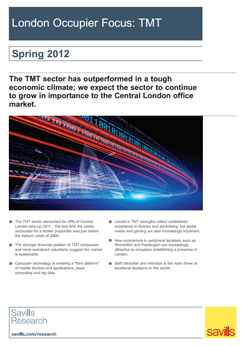London Occupier Focus: Technology Media and Telecommunications
Report Authors: Savills Research, UK Hotels & Healthcare
Report Summary:
The TMT sector accounted for 20% of Central London take-up 2011. The last time the sector accounted for a similar proportion was just before the dotcom crash of 2000.
The stronger financial position of TMT companies and more restrained valuations, suggest the market is sustainable.
Computer technology is entering a “third platform” of mobile devices and applications, cloud computing and big data.
London’s TMT strengths reflect established experience in finance and advertising, but social media and gaming are also increasingly important.
New submarkets in peripheral locations such as Shoreditch and Paddington are increasingly attractive to occupiers establishing a presence in London.
Staff attraction and retention is the main driver of locational decisions in this sector.
In 2011 occupier demand from the technology and creative sectors accounted for 20% of total take-up in central London, a level only exceeded in 2000, the year the dotcom bubble burst. This trend begs the question of whether demand is sustainable. If it is, what types of firm will drive future TMT demand? And what drives their location decisions?
Over the last 10 years, the TMT sector (Technology, Media, and Telecommunications) accounted for 13% of Central London take-up, in 2011 the sector accounted for 20%. This demand was spread across 126 deals, a figure only exceeded in 2000 and 2001, and amounting to 1.5 million sq ft of space.
The recent growth in the number of patents being filed point to further technological advancement whilst the growth in venture capital activity aimed at UK internet and communications companies suggest particular growth in these areas. Given continued activity by the likes of Google, Apple, and Facebook in Silicon Valley, major American tech companies will continue to account for significant amounts of demand and this is reflected by existing office requirements.
London’s tech entrepreneurs have been quick to adapt to technological developments which has led to the emergence Silicon Roundabout. Although there is little evidence of an exodus of occupiers from traditional areas, newcomers have less attachment to submarkets like Soho, Noho and Covent Garden. For the time being West End submarkets like Paddington, Kings Cross, and Victoria will continue to compete with the traditional areas to attract new entrants into the London office market.
About the Author:
The Savills Research team has gained a reputation for an innovative and proactive approach, which comes from a clear philosophy of market dynamics and an understanding of our clients needs.
The team is unique in providing advice and analysis to clients across all sectors of the property market: from rural property to offices; residential to retail and leisure; in both the UK and globally.
Our established research team, with some 20 years experience, has a strong reputation for producing accurate, well informed and above all else, independent analysis and commentary.
